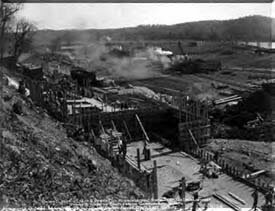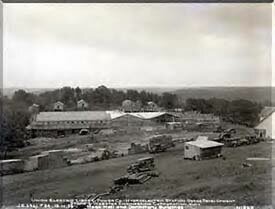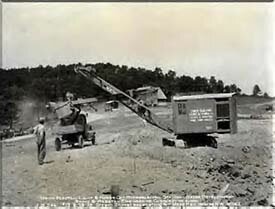The Great Osage River Project
You're free to read the full version of the article (and even order term papers that explore similar ideas) at the main page of the site.
The Great Osage River Project has been recognized as one of the greatest engineering and construction feats of its time. Site work began on August 6, 1929 by Union Electric Company of St. Louis, Missouri and the engineering corporation of Stone and Webster. The final price tag would be $30 million for the last and  largest major dam to be built in the United States entirely with private capital. Four months after construction began, came the stock market crash followed by many years of the Great Depression. The gigantic undertaking created a gold rush type scene. News spread quickly and prospective employees began pouring into the area. They came by foot, on horseback, floating down the river, piled high in trucks, and a few in automobiles. The area was so remote that roads were dirt and the nearest railway stopped 15 miles away in Eldon. During the worst depression that the United States had ever seen, Union Electric created nearly 10,000 new jobs and, at that time, the largest man-made lake in the world. There were some 4,600 craftsmen and laborers working at one point in time, twenty-four hours per day and seven days per week. During the next two years, the project would see 20,500 workers come and go.
largest major dam to be built in the United States entirely with private capital. Four months after construction began, came the stock market crash followed by many years of the Great Depression. The gigantic undertaking created a gold rush type scene. News spread quickly and prospective employees began pouring into the area. They came by foot, on horseback, floating down the river, piled high in trucks, and a few in automobiles. The area was so remote that roads were dirt and the nearest railway stopped 15 miles away in Eldon. During the worst depression that the United States had ever seen, Union Electric created nearly 10,000 new jobs and, at that time, the largest man-made lake in the world. There were some 4,600 craftsmen and laborers working at one point in time, twenty-four hours per day and seven days per week. During the next two years, the project would see 20,500 workers come and go.
Until the Great Osage River Project was started, this land was sparcely populated. Most of the residents were settlers who came because of the 1864 Homestead Act. That Act would allow 160 acre tracts of land to be deeded, at $1.25 per acre, if the person lived on the land for five years. Union Electric created its own city. Dormitories and mess halls were the first built, followed by a commissary, hospital, a concrete plant, miles of roads, and even a jail for the rowdy misbehavers.
Using equipment that seems pretty crude now, the total construction was completed in just two and a half years. Crews worked daylight to dark, and even 24 hours per day when it came to pouring concrete for the dam. A major phase of the construction was to build a 15 mile railroad from Eldon to a tiny town called  Bagnell, located 5 miles below the dam. Several more miles of rail was built from Bagnell to the dam site and several spur lines to deliver millions of tons of material to stockpile areas. A railway and wagon bridge was constructed about 200 yards below the dam site to cross the Osage River to deliver to the steel yard and the concrete plant.
Bagnell, located 5 miles below the dam. Several more miles of rail was built from Bagnell to the dam site and several spur lines to deliver millions of tons of material to stockpile areas. A railway and wagon bridge was constructed about 200 yards below the dam site to cross the Osage River to deliver to the steel yard and the concrete plant.
The mammoth project was divided into three major areas of activity. One part was the dam and power house. This also included all of the camps, contructing and maintaining roads, designing and building railways, and erecting a river bridge for rail, car, and wagons. Dozens of permanent and temporary structures were designed and fabricated. Many of the buildings are in use today, a full seventy years later. During low river water levels, wooden piers from the old bridge can still be seen. Steel pilings, girders, and cable are low river water hazards for boats and fishing lines. The dam is of concrete gravity type, 2543 feet long supporting a 20 foot wide roadway and three foot wide sidewalk. The power station is 511 feet long and the flood control spillway section is 520 feet long. The power plant produces 215,000 kilowatts mainly to the eastern part of Missouri and St. Louis. A second portion of the undertaking, was the electrical transmission lines to carry the generated power to the consumer. The third area of work, was the water reservoir. This included surveying nearly 100 square miles, clearing thousands of trees that covered 30,000 acres, mapping the whole 100 square miles, and outlining where the shoreline would be. The reservoir covers 57,000 acres or 92 square miles, has nearly 1,375 miles of shoreline (more shoreline than the sea coast of the State of California), and impounds 617 billion gallons of water. <>The dam was completed and the Lake, as of then, unnamed began to fill on February 2, 1931. The Lake was opened to use May of 1931, only four months after it started filling and two years before the end of the Prohibition Act. There are many more pictures for the history buff.
A second portion of the undertaking, was the electrical transmission lines to carry the generated power to the consumer. The third area of work, was the water reservoir. This included surveying nearly 100 square miles, clearing thousands of trees that covered 30,000 acres, mapping the whole 100 square miles, and outlining where the shoreline would be. The reservoir covers 57,000 acres or 92 square miles, has nearly 1,375 miles of shoreline (more shoreline than the sea coast of the State of California), and impounds 617 billion gallons of water. <>The dam was completed and the Lake, as of then, unnamed began to fill on February 2, 1931. The Lake was opened to use May of 1931, only four months after it started filling and two years before the end of the Prohibition Act. There are many more pictures for the history buff.
List of Works Consulted
Carole Tellman Pilkington,The Story of Bagnell Dam,Lake Area Chamber of Commerce,1989
National Register of Historic Places,NPS form 10-900-a,section 7.
Buford Foster,That's The Way It Was,1978
T. Victor Jeffries,Before The Dam Water,1974
AmerenUE,Bagnell Dam Construction Photos,1929-1931
Video Productions Unlimited,Current Photos,1990's
News